|
|
Catalogues and Consumer Loyalty (Page 2)
<< Page 1
Patriotism and Pride Help Make the Sale
| |
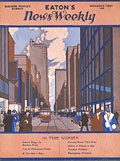 |
|
| |
 Eaton's
News Weekly was published for business people, one of the many examples
of how companies adapted to their clientele. Eaton's News Weekly, November
1924. Eaton's
News Weekly was published for business people, one of the many examples
of how companies adapted to their clientele. Eaton's News Weekly, November
1924.
|
|
| |
|
|
|
A highly regionalized country, Canada made it possible for companies to
target
various groups: western farmers, miners, members of the Quebec clergy,
Maritime
fishermen, etc. Certain companies specialized, while others sought a
national
market. This shows that companies were adaptable and made every effort to
reach
as many consumers as possible. It is not surprising, therefore, that, in
1898,
Eaton's published a Klondike Catalogue especially for people who were
participating
in the gold rush. In 1903, the Toronto firm adapted to another reality
with the
Settlers' Catalogue for the new settlers arriving in the West. Another
example
is the Business People's Number, published in 1924. Essentially, the point
to
bear in mind is that Eaton's, like its main rivals, made it its duty to
adapt
to the market by every means possible. However, two of the most
influential department
stores, Dupuis Frères and Eaton's, distinguished themselves from
their
competition by drawing on patriotism to secure consumer loyalty.
|
| |
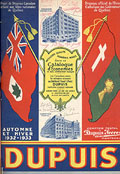 |
|
| |
 "Let's
help one another. Co-operation is the key to success." (translation)
This Dupuis Frères slogan is representative of the company's
advertising
strategy. Dupuis Frères Fall/Winter Catalogue, 1932-33, cover. "Let's
help one another. Co-operation is the key to success." (translation)
This Dupuis Frères slogan is representative of the company's
advertising
strategy. Dupuis Frères Fall/Winter Catalogue, 1932-33, cover.
|
|
| |
|
|
|
Dupuis Frères
Dupuis Frères is certainly the most eloquent example of a
company that
invited the population to buy "French Canadian" to further the survival of
a
race. A veritable empire that controlled an extremely large share of the
Quebec
market, the Montréal store never hid its patriotism, and proclaimed
loudly
and clearly that it was the largest French store in North America. Added
to this
clearly stated patriotism was the pride of having accomplished a "feat,"
that
is, having established a company that was owned, managed, and kept afloat
by
French Canadians.
| |
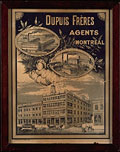 |
|
| |
 Dupuis
Frères: an economic force. In Montréal, Dupuis Frères
could boast about
making it difficult for Eaton's and Simpson's, two large Toronto companies,
to penetrate the Quebec market. Dupuis
Frères: an economic force. In Montréal, Dupuis Frères
could boast about
making it difficult for Eaton's and Simpson's, two large Toronto companies,
to penetrate the Quebec market.
|
|
| |
|
|
|
Through Duprex, a publication that served as a tool for communication
between
the employees and the company, Dupuis Frères drew on patriotism to
encourage
its employees and to convince them that it was a just cause, but also, and
above
all, to make them convincing, once they were convinced. For example, in a
1927
issue of Duprex, the company stated that "in a country such as ours,
submerged
by immigration, surrounded by US, British or Jewish financing, we do not
have
the right to be ordinary, mediocre, inferior, and to resign ourselves to
the
perpetual role of hewers of wood and drawers of water, obsequious and
fearful
servants. In this Canada that was discovered, colonized, and evangelized
by our
own people, we have a moral obligation [to show ourselves] as superior in
distinction,
knowledge, and value." [transl.] (Cited by M. C. Matthews in his MA,
1998.)
| |
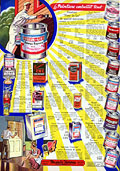 |
|
| |
 It
was not by chance that the ad for this painting of a fleur-de-lys was
placed on the back cover of the catalogue. It fits in with the vision
of pride and patriotism advocated by the Montréal department store.
Dupuis
Frères Spring/Summer Catalogue, 1944. It
was not by chance that the ad for this painting of a fleur-de-lys was
placed on the back cover of the catalogue. It fits in with the vision
of pride and patriotism advocated by the Montréal department store.
Dupuis
Frères Spring/Summer Catalogue, 1944.
|
|
| |
|
|
|
The use of patriotism was clearly one of the highlights of the
promotional
advertising strategy employed by Dupuis Frères throughout its
history.
This can be explained by the fact that the company clearly gave itself the
mission
of working towards an economic conquest by French Canadians, and in
particular
Quebeckers. As a result, it structured its advertising around the concept
of
pride, pride in language, faith, and homeland. It is not surprising,
therefore,
that Dupuis often used the traditional fleur-de-lys, as well as the maple
leaf.
| |
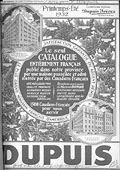 |
|
| |
 Like
Eaton's, Dupuis Frères employed the maple leaf as a national or
patriotic
symbol. However, the Montréal company's ideology focused more on the
survival of the French Canadian race, as this image shows. Dupuis
Frères
Spring/Summer Catalogue, 1932, cover. Like
Eaton's, Dupuis Frères employed the maple leaf as a national or
patriotic
symbol. However, the Montréal company's ideology focused more on the
survival of the French Canadian race, as this image shows. Dupuis
Frères
Spring/Summer Catalogue, 1932, cover.
|
|
| |
|
|
|
The company also claimed that it served the interests of French
Canadians
and the Catholic clergy, so it did not hesitate to use various
expressions, harangues,
and words as strategies to achieve consumer loyalty. Defining itself as a
national
institution, the firm endorsed the view that the survival of French
Canadians
was a miracle in a British country. This strategy was rather effective,
since
Dupuis Frères was the main competitor of the major Toronto
companies,
Eaton's and Simpson's, and made it difficult for them to penetrate the
Quebec
market.
|
Eaton's
| |
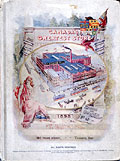 |
|
| |
 Eaton's
regularly used slogans such as "Canada's Greatest Store" to distinguish
itself from its competitors. This type of formula made the company more
visible and seems to have been effective. Eaton's Spring/Summer Catalogue,
1898, cover. Eaton's
regularly used slogans such as "Canada's Greatest Store" to distinguish
itself from its competitors. This type of formula made the company more
visible and seems to have been effective. Eaton's Spring/Summer Catalogue,
1898, cover.
|
|
| |
|
|
|
As Lorraine O'Donnell showed in her research, covers of Eaton's
catalogues
with a Canadian theme offered a particular vision of the company with
respect
to the country. Eaton's positioned itself as a key element of national
development
and Canadian identity. The company's name, the T. Eaton Company of Canada
(and
later, Eaton's of Canada), reflected the idea that Eaton's was an
important force
in the development of Canada. The company also boasted about its
mail-order service,
which was offered from coast to coast, even in the most remote areas. As
early
as 1887, Eaton's informed its customers that its catalogue would go
wherever
the maple leaf was found within the Dominion.
| |
| |
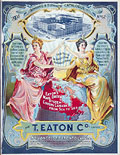 |
|
| |
 Eaton's
mail-order service extended from coast to coast. Eaton's Spring/Summer
Catalogue, 1904, cover. Eaton's
mail-order service extended from coast to coast. Eaton's Spring/Summer
Catalogue, 1904, cover.
|
|
| |
|
|
|
Eaton's promoted itself as the Canadian department store that marketed
the
widest variety of products throughout the country. In doing so, it
emphasized
that Eaton's was a Canadian company managed by Canadians, present in every
region,
selling Canadian products to meet the needs of Canadians. The company
clearly
appealed to a sense of patriotism, so it is not surprising that the first
page
of the catalogue regularly featured a visual image of Canada in the form
of a
map or globe highlighting the country.
| |
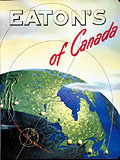 |
|
| |
 Eaton's
was present throughout Canada. The company highlighted this in ads that
emphasized the country's geography. Eaton's Spring/Summer Catalogue,
1950, cover. Eaton's
was present throughout Canada. The company highlighted this in ads that
emphasized the country's geography. Eaton's Spring/Summer Catalogue,
1950, cover.
|
|
| |
|
|
|
Other symbols such as the maple leaf, the beaver, the coat of arms, and
the
flag were used to evoke Canada. The colours of the Canadian flag, excerpts
from
the Proclamation of Confederation, or the image of the Parliament
buildings
strengthened the ties between Eaton's and the Canadian population.
It should be noted that these deliberately nationalistic ads were found
more
often in the Toronto editions of the Eaton's catalogue. It is clear that
the
editors of the Winnipeg and Moncton editions did not necessarily play on
patriotic
feelings. On the other hand, an image that was heavy with meaning —
that
of newcomers settling on their land in the West — helped show the
importance
attached to Confederation, a recent undertaking at the time.
| |
 |
|
| |
 This
image of a western farmer looking towards the future of his country was
imprinted on the collective imagination. Eaton's Fall/Winter Catalogue,
1920-21, cover. This
image of a western farmer looking towards the future of his country was
imprinted on the collective imagination. Eaton's Fall/Winter Catalogue,
1920-21, cover.
|
|
| |
|
|
|
The newcomers in turn became a key element of national development and
forged
Canada's identity in their own way. Adapting to the target audience was,
therefore,
a priority in the main ads in Eaton's catalogues. There may have been
differences
in the approach, but the basic mechanisms and the common patterns were
maintained.
In short, the Winnipeg and Moncton distribution centres, for example, did
not
go against Eaton's advertising principles and inevitably remained under
Toronto's
normative influence.
|
The Need to Adapt
| |
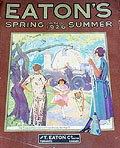 |
|
| |
 Modern
conveniences can fit quite well into a rural setting, as illustrated
in this image that is heavy with meaning. Eaton's Spring/Summer Catalogue,
1926, cover. Modern
conveniences can fit quite well into a rural setting, as illustrated
in this image that is heavy with meaning. Eaton's Spring/Summer Catalogue,
1926, cover.
|
|
| |
|
|
|
The department stores were always willing to adapt and modify the
design of
their catalogues to keep their customers. The country's increasing
modernization
and the idea of progress forced them to revise their ads. For example,
when they
used images of farmers labouring in the wheat fields, they took care to
illustrate
the progress achieved in agriculture. Better still, the image of the
western
farmer who looked to the future of the country, its open spaces, forests,
and
urbanization definitely left its imprint on the collective imagination.
Similarly,
the inclusion of desired accessories in the photographs, such as an
automobile
in a rural area, made it possible to show technological improvements and
elements
of modernization.
| |
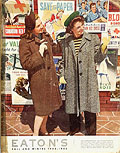 |
|
| |
 The
catalogues were adapted to the reality of war in their own way. In this
example, two young women indirectly promote the donation of blood and
invite women to contribute to the war effort. Eaton's Fall/Winter
Catalogue,
1944-45, cover. The
catalogues were adapted to the reality of war in their own way. In this
example, two young women indirectly promote the donation of blood and
invite women to contribute to the war effort. Eaton's Fall/Winter
Catalogue,
1944-45, cover.
|
|
| |
|
|
|
As the years went by, retailers began to use more images of people who
were
politically involved, such as women who showed their patriotism by waving
flags
or by encouraging people to donate blood in wartime.
| |
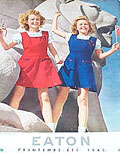 |
|
| |
 The
Allied victory in the Second World War inspired numerous ads. This one
was no exception. Eaton's Spring/Summer Catalogue, 1945, cover. The
Allied victory in the Second World War inspired numerous ads. This one
was no exception. Eaton's Spring/Summer Catalogue, 1945, cover.
|
|
| |
|
|
|
At the end of the Second World War, several companies exploited the
theme
of victory. In one ad, children were depicted as symbols of victory, each
holding
a flag that was highly significant (those of Canada and Britain) and
standing
in front of the famous lion that represented the power of Britain.
|
| |
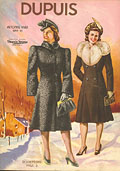 |
|
| |
 In
many large ads, a woman occupies most of the image. She was the one who
had to be highlighted because she was at the centre of the purchasing
process. Dupuis Frères Fall/Winter Catalogue, 1944-45, cover. In
many large ads, a woman occupies most of the image. She was the one who
had to be highlighted because she was at the centre of the purchasing
process. Dupuis Frères Fall/Winter Catalogue, 1944-45, cover.
|
|
| |
|
|
|
Conclusion
Securing consumer loyalty through mail-order catalogues inevitably
involved
commercial imagery. Such imagery encompassed various strategies of
promotional
advertising that can easily be observed on catalogue covers and in main
ads.
As a result, the messages that retailers wanted to convey were, for
example,
built mainly around images. Women inspired the designers quite often,
since they
were at the heart of the process of catalogue shopping.
| |
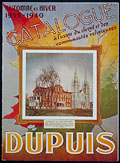 |
|
| |
 This
edition for the clergy and religious communities clearly illustrates
how companies adapted. They did not hesitate to modify their approach
slightly to gain consumer loyalty. Dupuis Frères Fall/Winter
Catalogue,
1939-40, cover. This
edition for the clergy and religious communities clearly illustrates
how companies adapted. They did not hesitate to modify their approach
slightly to gain consumer loyalty. Dupuis Frères Fall/Winter
Catalogue,
1939-40, cover.
|
|
| |
|
|
|
In addition, the importance attached to consumer loyalty is reflected
in the
fact that companies adapted to their clientele. As Canada is a highly
regionalized
country with a diverse population, retailers wanted to satisfy as many
people
as possible by adapting to their reality. It is not surprising that
certain differences
can be identified in the approaches taken by the companies, who often
deemed
it appropriate to focus on a more specific clientele at a particular point
in
time. However, the basic mechanisms and the common patterns were always
maintained
in order to secure the loyalty of each of those groups using identical
procedures.
Viewed from this perspective, no matter where they lived, consumers
identified
directly or indirectly with "their" store, with the one that contributed
the
most when it came to forging their personal identity and affirming their
membership
in the community. This proves that catalogues stimulate interaction
between consumers
and companies.
|
Further Reading
Breton, Philippe and Serge Proulx. "Publicité, communication et
consommation."
In L'explosion de la communication : la naissance d'une nouvelle
idéologie,
pp. 103-118. Montréal: Boréal, 1991.
Côté, Luc and Jean-Guy Daigle. Publicité de
masse
et masse publicitaire: Le marché québécois des
années
1920 aux années 1960. Ottawa: University of Ottawa Press,
1999.
Idoux, Raymond. "Marchandises en vedette: Eaton et l'imagerie
commerciale."
In Cap-aux-Diamants 40 (Winter 1995): 48-51.
Lambert, Anne. "Images for Sale: How Eaton's Saw Us." Branching
Out
4 (March-April 1977): 30-33.
Matthews, Mary Catherine. "Working for Family, Nation and God:
Paternalism
and the Dupuis Frères Department Store, Montreal, 1926-1952." M.A.
Thesis,
McGill University, 1998.
Monod, David L. Store Wars: Shopkeepers and the Culture of Mass
Marketing,
1890-1939. Toronto: University of Toronto Press, 1996.
O'Donnell, Lorraine M. "A Small World: Representations of Women in the
Eaton's
Catalogue Covers, 1886-1975." Paper presented at the Annual Conference of
the
Canadian Historical Association, May 2001. Preliminary version of a
chapter included
in her PhD thesis, "Visualising the History of Women at Eaton's,
1869-1976."
Trudel, Robert. "Famille, Foi et Patrie: le credo de Dupuis
Frères!"
In Cap-aux-Diamants 40 (Winter 1995): 26-29.
|
|